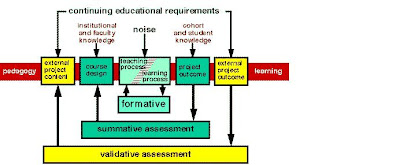The Buck Institute for Education was founded in 1987 to improve education by developing the teaching practice for Project-Based Learning (PBL) in order to give students real world experiences. The reason I chose this website is because it brings together many partners in educational research for PBL to support teachers and engaging students. The research is an important area of the organization’s goal for design, evaluation of learning methods, professional development, and collaboration with many school design organizations. It will be necessary for the school librarian to collaborate with the teacher in the management of student groups and assisting with technological resources. This website is important for my topic as it moves through different pages to explain what PBL is, examples, online project libraries, advice from teachers in preparation, planning, and assessing. It also includes a research page with many articles the design is based on.
Friday, July 9, 2010
Competency 9: Internet
The Buck Institute for Education was founded in 1987 to improve education by developing the teaching practice for Project-Based Learning (PBL) in order to give students real world experiences. The reason I chose this website is because it brings together many partners in educational research for PBL to support teachers and engaging students. The research is an important area of the organization’s goal for design, evaluation of learning methods, professional development, and collaboration with many school design organizations. It will be necessary for the school librarian to collaborate with the teacher in the management of student groups and assisting with technological resources. This website is important for my topic as it moves through different pages to explain what PBL is, examples, online project libraries, advice from teachers in preparation, planning, and assessing. It also includes a research page with many articles the design is based on.
Competency 8: Research Visual/Multimedia
I found this image by searching project based learning on Google Images. http://www-cdr.stanford.edu/~leifer/publications/Osaka95/images/Osaka953.gif
I chose this image because I believe that it represents the research indicating how learners access their own learning in producing the project or final outcome in project based learning education. At the time of this research, technology was still evolving and the research proposed that Project-Based learning would become widespread and that the student products would support the curriculum and learning process (Leifer, 1995). I believe that this validates the need for continued research and the vision of how technology will become essential in the learning process. The research was carried out in the Center for Design Research in the Department of Mechanical Engineering at Stanford University, Stanford, CA for undergraduate and graduate students, but it can be seen how this educational process can be utilized in all grade levels.
Leifer (1995) stated the following:
Project-Based-Learning is both old and new. It is familiar as the classical conveyor of skills through apprenticeship. It is new as re-interpreted to be the formal process of linking and integrating theory and practice. Through emerging communication technology it is almost revolutionary in given power back to the learner to structure and assess one's own learning performance at all levels of professional development. (Conclusion section, para. 1)
Copyright information:
Leifer, L. (1995). Evaluating Product-Based-Learning Education. Paper presented at 1995 Osaka Conference. Retrieved July 8, 2010, from http://www-cdr.stanford.edu/~leifer/publications/Osaka95/Osaka95.html
Thursday, July 8, 2010
Competency 7: Image
I chose this image because it replicates the sequence of steps in which educators and librarians can follow when utilizing the teaching strategy implementing project based learning. The tutorial defines the concept of project based learning (PBL) and each corresponding step presented in the image. During the search process the image was found to be part of a paper from Kerry Lynn Rice, M.S. http://edtech.boisestate.edu/krice/PBL/developing_an_interactive_course.htm which sites the website Project Based Learning, The Online Resource for PBL at the link http://pbl-online.org/default.htm. When retrieved from the website, the image is interactive so that each module can be explored. I noticed that this image was being posted by other individuals’ blogs or wikis. It was an interesting search in itself to locate the origin of the image. I found the image helpful in understanding how to create this type of learning environment. For example, in the first module, Begin with the End in Mind, it has 6 areas or exploration and 2 areas for practice: Develop a Project Idea, Decide the Scope of the Project, Select Standards, Incorporate Simultaneous Outcomes, Work from Project Design Criteria, Create the Optimal Learning Environment, Choose a Strategy, and Choose a Project. This image led me to an amazing website.
Copyright information:
Department of Educational Technology, Boise State University (2005). Standards-Focused Project Based Learning Online Course. Retrieved July 9, 2010, from The Buck Institute for Education and Boise State University, Boise, ID. Web site: http://pbl-online.org/default.htm.

